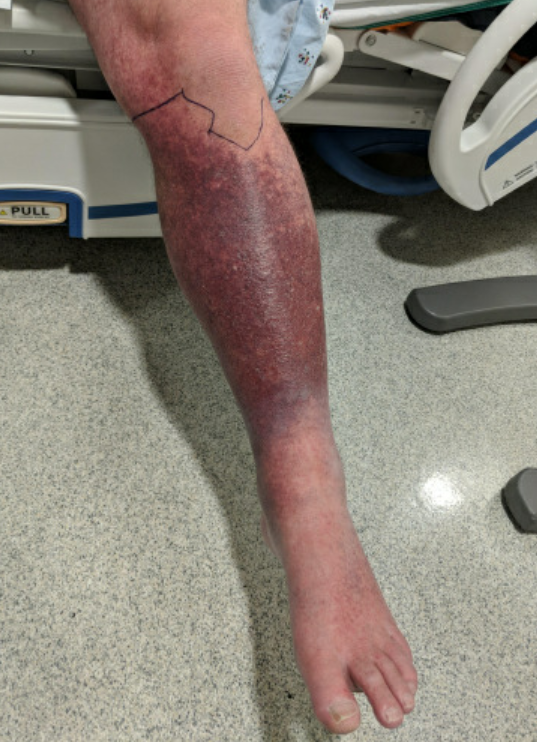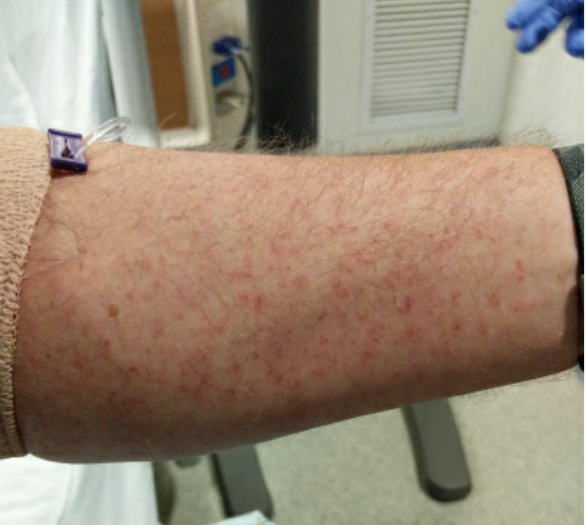Case Presentation: A 57-year-old male presents with a morbilliform rash on his extremities, trunk, and back. One week prior, he started sulfamethoxazole/trimethoprim for cellulitis. On his sixth day of treatment, the patient became acutely febrile to 102°F, with rash eruption one day later. Therefore, he presented to the hospital for further evaluation. On arrival, he was afebrile, resting comfortably without conjunctival injection, mucosal lesions, or lymphadenopathy. Petechiae were on the bilateral upper extremities that coalesced into large patches on the bilateral lower extremities. A blanching, erythematous rash was on the trunk and back. Initial laboratory work up was remarkable for a platelet count of 112,000, AST 124, ALT 217, and bilirubin 3.0. He had no leukocytosis nor eosinophilia. Dermatology was consulted, he was diagnosed with Drug Reaction with Eosinophilia and Systemic Symptoms (DRESS), and treated with a thirty-day prednisone taper. At discharge, he was afebrile, with improving liver function tests. On outpatient follow-up, his rash had resolved after twenty-one days of treatment.
Discussion: DRESS is a severe, drug-induced type IV hypersensitivity reaction, with an estimated population risk of one case per every thousand to ten thousand drug exposures and carries a 10% mortality rate. Common culprit medications are anticonvulsants, sulfonamides, vancomycin, and allopurinol. Clinical manifestations after drug exposure remain latent up to several weeks and include fever, skin lesions, and internal organ involvement. Lymphadenopathy and eosinophilia are also classic findings, but may not appear for several weeks after rash onset, and are not required for diagnosis. The diagnosis of DRESS is clinical, and does not require skin biopsy. Of the three sets of diagnostic criteria proposed for DRESS, the Registry for Severe Cutaneous Adverse Reactions (RegiSCAR) criteria is designed specifically for inpatient use. First, the patient must meet inclusion criteria: hospitalization and drug-related reaction, in addition to three of five other features, including rash, fever >100.4°F, lymphadenopathy of ≥ two sites, involvement ≥ one internal organ, and blood count abnormalities. If met, then validation criteria are used, with additional considerations (e.g. illness duration and rash extent), to give a score that classifies the potential of a DRESS diagnosis from “no case” to “definite case”. Management involves withdrawal of the suspected causative drug, supportive care, and in patients with organ involvement, oral prednisone of 1.0 mg/kg is initiated and tapered.
Conclusions: Our patient presented with fever, rash, and hepatic involvement, while lacking classic eosinophilia. He still met RegiSCAR criteria as a “possible” DRESS case, and was treated with ultimate symptom resolution. Overall, this case emphasizes the importance of maintaining a high clinical suspicion for DRESS even in the absence of the characteristic findings (e.g. eosinophilia), as the criteria for diagnosis of DRESS are wider than the name of this disease suggests.


